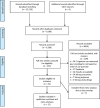Is e-cigarette use in non-smoking young adults associated with later smoking? A systematic review and meta-analysis
- PMID: 32156694
- PMCID: PMC7803902
- DOI: 10.1136/tobaccocontrol-2019-055433
Is e-cigarette use in non-smoking young adults associated with later smoking? A systematic review and meta-analysis
Abstract
Objective: The aim of this review was to investigate whether e-cigarette use compared with non-use in young non-smokers is associated with subsequent cigarette smoking.
Data sources: PubMed, Embase, Web of Science, Wiley Cochrane Library databases, and the 2018 Society for Research on Nicotine and Tobacco and Society for Behavioural Medicine conference abstracts.
Study selection: All studies of young people (up to age 30 years) with a measure of e-cigarette use prior to smoking and an outcome measure of smoking where an OR could be calculated were included (excluding reviews and animal studies).
Data extraction: Independent extraction was completed by multiple authors using a preprepared extraction form.
Data synthesis: Of 9199 results, 17 studies were included in the meta-analysis. There was strong evidence for an association between e-cigarette use among non-smokers and later smoking (OR: 4.59, 95% CI: 3.60 to 5.85) when the results were meta-analysed in a random-effects model. However, there was high heterogeneity (I2 =88%).
Conclusions: Although the association between e-cigarette use among non-smokers and subsequent smoking appears strong, the available evidence is limited by the reliance on self-report measures of smoking history without biochemical verification. None of the studies included negative controls which would provide stronger evidence for whether the association may be causal. Much of the evidence also failed to consider the nicotine content of e-liquids used by non-smokers meaning it is difficult to make conclusions about whether nicotine is the mechanism driving this association.
Keywords: addiction; co-substance use; electronic nicotine delivery devices.
© Author(s) (or their employer(s)) 2020. Re-use permitted under CC BY. Published by BMJ.
Conflict of interest statement
Competing interests: MRM and AET report grants from Pfizer, outside the submitted work.
Figures




References
-
- Public Health England E-cigarettes: an evidence update, 2015.
Publication types
Grants and funding
LinkOut - more resources
Full Text Sources
